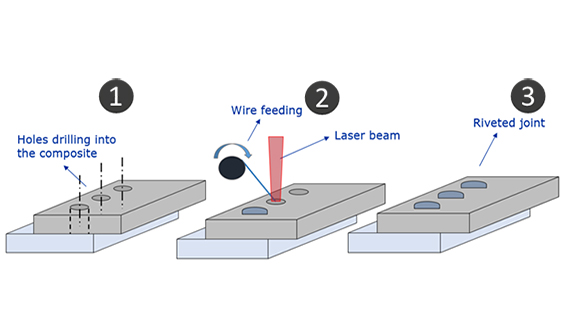Wed, 25 September, 2019
TWI is embarking on a new composite to metal joining project as part of the core research programme alongside industry mentors GKN Aerospace and Gestamp.
The aim of the project is to design and produce a composite-metal assembly whose interface region is a “transition” zone, tailored to each application and geometry. This “transition” joint, which can be manufactured elsewhere and then brought onto the production line, will be produced by a variety of different approaches, including the laser riveting method.
Background
Industries in the transport sector, including aerospace and automotive, have interest in exploring innovative solutions for joining dissimilar materials. The key drivers behind this include:
- Reducing the weights of structures; light weighting reduces CO2 emission and improves the fuel economy. Driven by European Regulations (No. 443/2009) and the USA Corporate Average Fuel Economy (CAFE) standard, automotive and aerospace companies are increasingly looking to use carbon fibre composites to achieve up to 50% weight savings over metallic alternatives
- Enabling novel design of vehicles, in order to optimise their performance. Engineered functional structures could be made by the integration of different materials selectively associated to different components
Composites offer high specific strength and stiffness, corrosion resistance and fatigue resistance, whereas metals provide solutions for higher temperature resistance, energy absorption, high bearing load resistance, and (typically) lower cost.
Currently, most challenging multi-materials assemblies are mechanically fastened and/or adhesive bonded. However, the limitations associated to using these two techniques include extra weight, cost and durability issues. These drawbacks limit the adoption of more advanced multi-material joining applications and reduce the potential benefits of optimised designs. Consequently, there is a need for new, flexible, cost-effective and rapid methods for joining dissimilar materials, capable of meeting industry performance and manufacturing demands.
Concept
The concept for this work consists of joining two components (specifically a composite and a metal) by additively manufacturing a metal rivet. The rivet will enable the assembly thanks to the effect of a compressive tension status.
The main phases of the process (see diagram below) are:
- Firstly, making a hole in the composite. This hole could be made using a laser or by thermal assisted piercing
- This is followed by the controlled delivery of laser melted filler material through this hole to additively build a rivet
- The rivet will interlock the composite sheet to a metal surface underneath
Objectives
The programme aims to improve the fundamental empirical understanding of key variables and their influence on a joint’s properties. In addition, the work will prove the capabilities of the process in terms of higher productivity for the joining process when compared to mechanical fastening and adhesive bonding. This higher productivity should occur due to the short time taken for riveting combined with a lower curing time, lower time for alignment, and no adhesive clogging. The riveting process will also offer a lower weight (<50% compared to mechanical fastening).
The project will also aim to technically evaluate a combination of more processes for a hybrid joining technique, assess material properties and identify post processing techniques.
An accurate numerical model will also be validated with experimental data and a techno-economical comparison of the technology will be benchmarked against traditional techniques, with combined technologies also to be considered.
The picture below details the phases of the joining technique:
 Figure 1. Laser riveting technical concept
Figure 1. Laser riveting technical concept